Here, I’ve explained shifter and brake cable & housing standards. From my experience, many problems with poor shifting, or braking, come from using incorrect components. Separate posts explain:
– Brake and shifter cable routing.
– When you should lubricate cables.
TL/DR
Using brake housing for shifters makes your shifting suck.
Using shifter housing for brakes is outright dangerous!
In this article, I’ve explained how to tell what is what, and gave some buying recommendations (from my decades of experience).
It’s not long – I just put many pictures to help you understand and see the differences. 🙂
1. Shifter (derailleur) cable standards – differences
Shifter cables have a barrel on one end, that is used for shifter to pull (and release) the cable, while the other end is soldered, so that wires don’t get unwinded and so that the cable can more easily be routed (and cut to the appropriate length after routing).
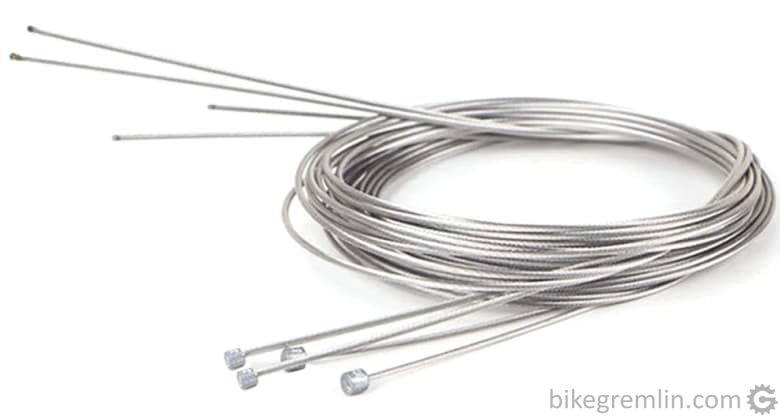
Picture 1
Shifter (derailleur) cables come in two standards, main difference being the end barrel, though cable thickness also tends to differ:
- Campagnolo standard – 1.1 to 1.2 mm cable diameter, with a bit smaller diameter barrel at the end
- Others (Shimano, SRAM…) – around 1.2 to 1.3 mm cable diameter – with end barrel a bit larger than Campagnolo one
Apart from the diameter, Campagnolo and Shimano shifter cables are visually almost identical, so pay attention to specifications when shopping (especially if you have Campagnolo shiters, since Shimano cables won’t fit Campagnolo shifters).
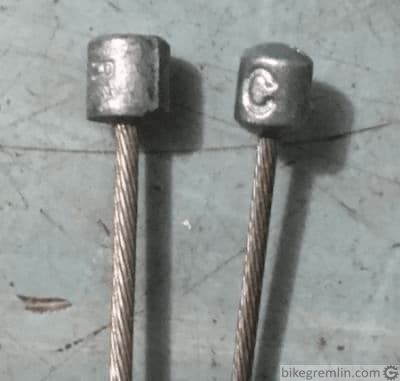
Picture 2
2. Brake cable standards – differences
To avoid/prevent any confusion, I’ll explain brake cables (and housing) as well in this post.
Brake cables come in three standards, with the main difference being the size and shape of the end barrel:
- MTB – with a large barrel on one end
- Road Shimano compatible – for Shimano and SRAM shifters
- Road Campagnolo
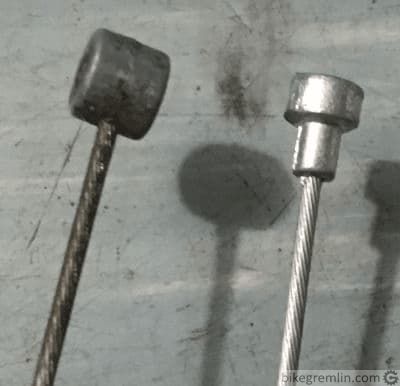
Picture 3
With road cables, Shimano ones have a bit larger barrel, though very similarly shaped. In fact, some manufacturers (like Jagwire, for all I know) make road bike brake cable ends such that barrels are a bit on the smaller side, hence the same model fits both Shimano and Campagnolo brake levers.
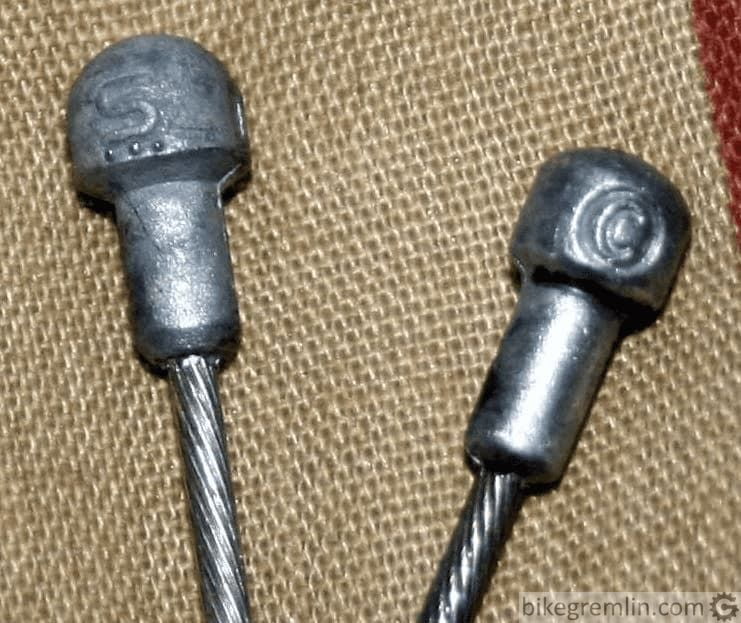
Source: bikehub.co.za forum
Picture 4
Cable thickness is about 1.5 to 1.6 mm, for both Shimano and Campagnolo.
3. Shifter housing standards
For shifter housing there are two standards:
- Shifter housing with 4 mm outer diameter.
- Shifter housing with 5 mm outer diameter (the same diameter, but not the same type, as brake housing).
All the shifter cables will run with no problems through housing by any of the above noted standards. Some MTB riders prefer 5 mm housing, since it leaves more room, so they don’t get stuck with mud that easily. Though, for 4 mm shifter housing, Shimano makes seals that prevent the entrance of dirt:
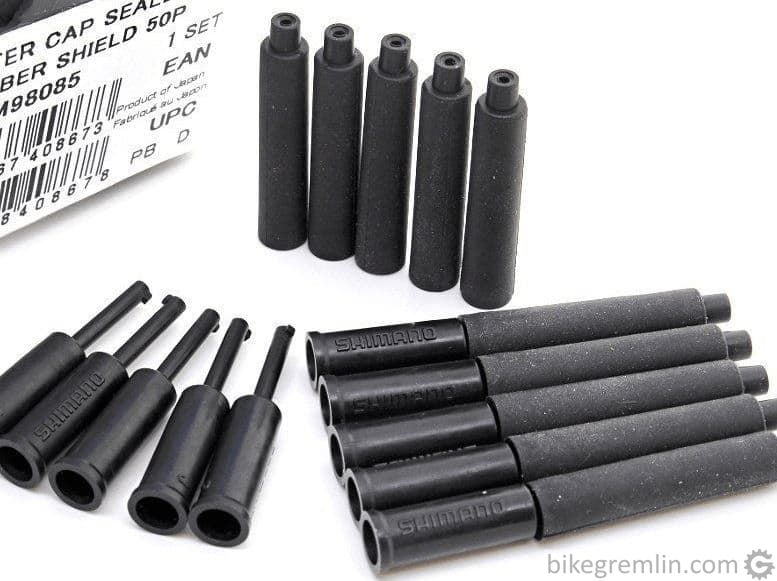
Picture 5
For 5 mm shifter housing ends, the same (metal) ends can be used as for brake housing (even though those are two different housing types!).
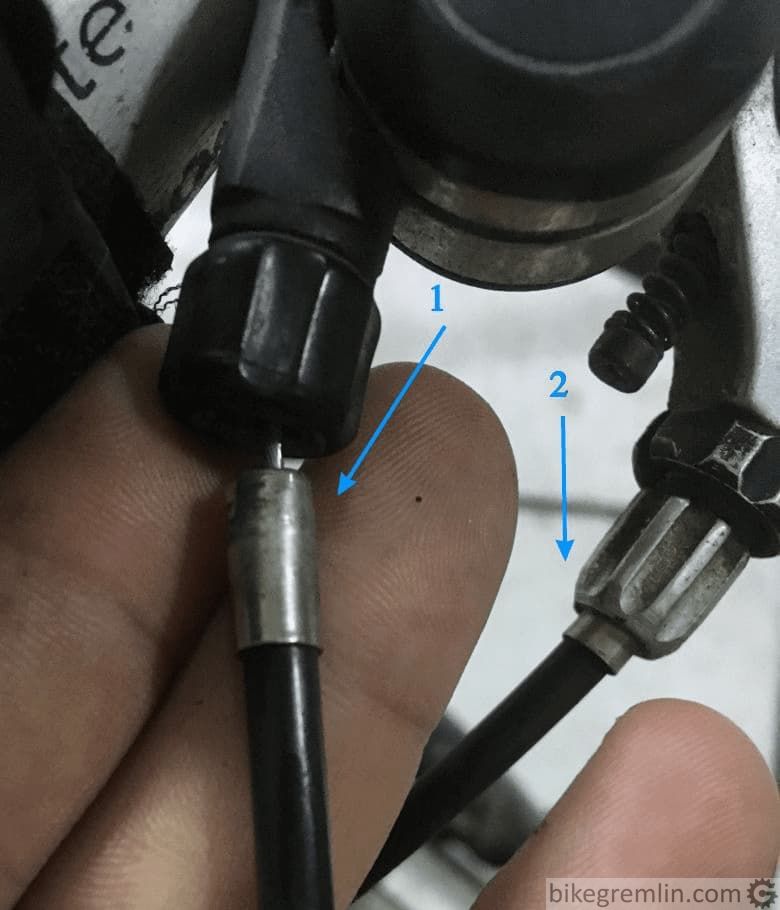
They look identical from the outside
Picture 6
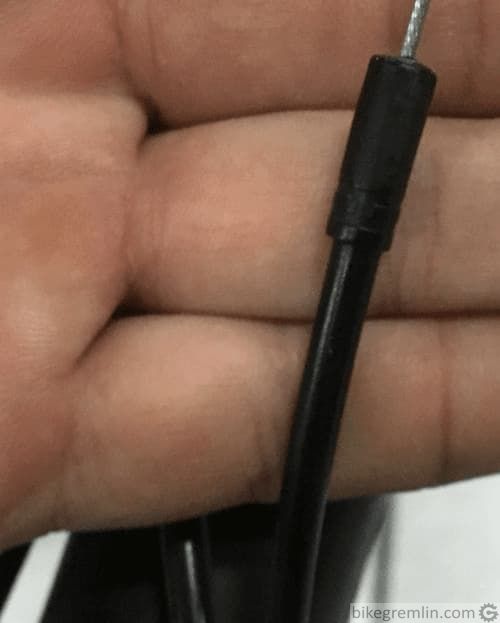
Picture 7
Important note: Shimano seels (at least here, in Serbia) two shifter housing models:
- Shimano SP40 SIS. This one doesn’t work very well and I don’t know what it is good for. On the outside, it looks like the proper shifter housing: is only 4 mm wide (brake housing is usually 5 mm wide), and has SIS (Shimano Indexing System) written on it. But, it has a spiral steel “skeleton,” like the one used in brake housing – stronger, but more flexible.
- Shimano OT-SP41 SIS. This is the proper shifter housing. It is also 4 mm wide (outer diameter), but has the longitudinally lined steel wires, making it stiff in terms of shifter cable for-aft movement, resulting in more precise shifting. See picture 8 below for the difference between this, and brake housing “skeleton.”
SP40 does work a bit better with shifters, compared to brake housing (low-end bicycles sold locally often come with brake housing used for both brakes, and shifters). But it is still inferior to OT-SP41 in terms of shifter precision.
4. Brake housing standards
With bicycle brake housing standards there aren’t any differnces – they are all 5 mm outer diameter with steel end caps. Apart from hydraulic brake hoses, of course, but that’s a different matter.
5. IMPORTANT: difference between brake and shifter housing
Too often I see brake and shifter housing mixed. But this is not good, and can even be dangerous!
- Shifter housing is constructed to compress and elongate as little as possible with shifter cable tension change (while shifting up and down). But it can not take large force – pull cable strong enough and it will split!
- Brake housing is made to sustain very high cable tension forces without splitting, but slight compression is not as detrimental.
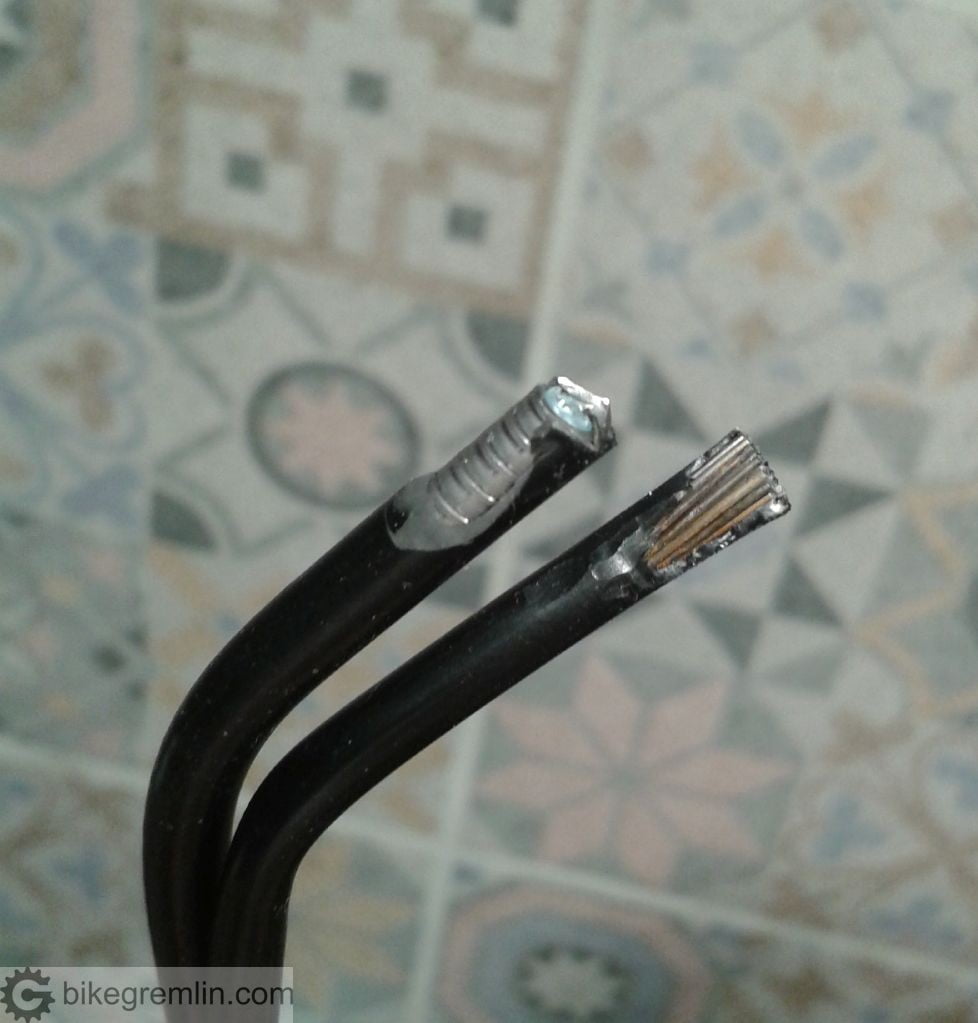
Left: brake housing with a woven strong steel spiral.
Right: shifter housing, with steel wires running along the housing length, to minimize compression and elongation changes.
Picture 8
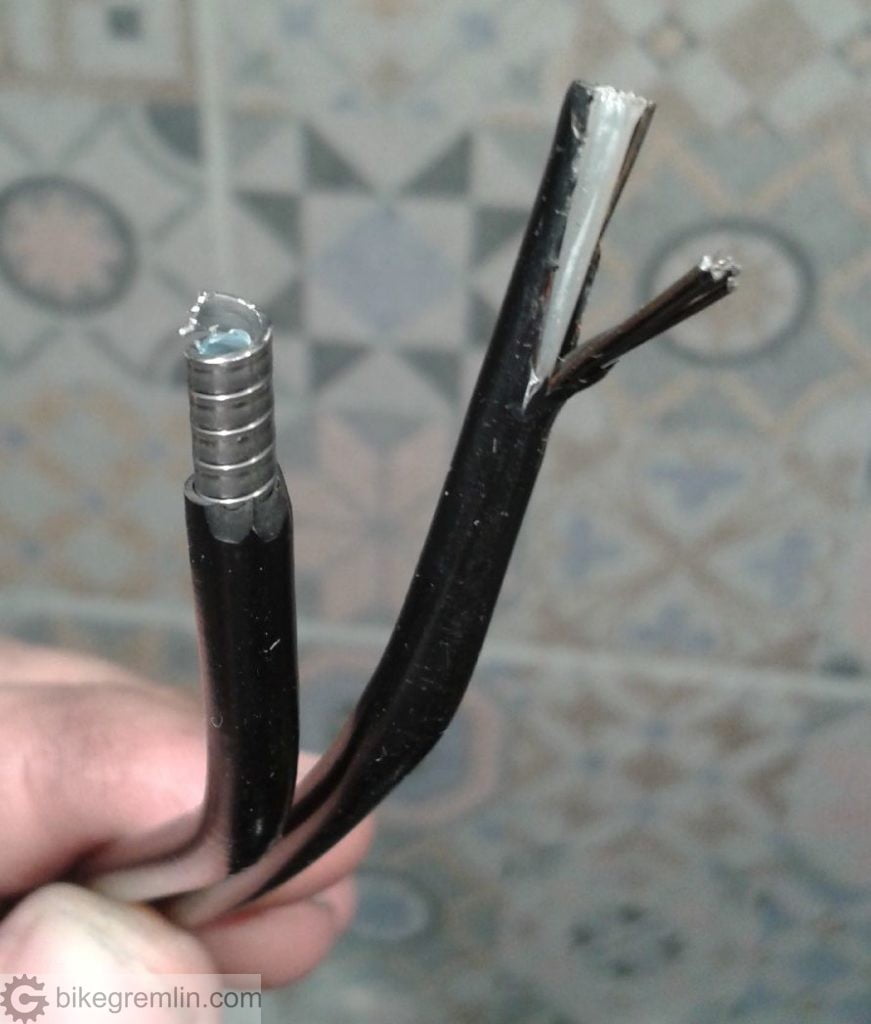
Right: shifter housing. Parallel steel wires prevent the housing from compressing (effectively changing length), but offer little resistance to high forces, so it can’t be used as a brake housing
Picture 9
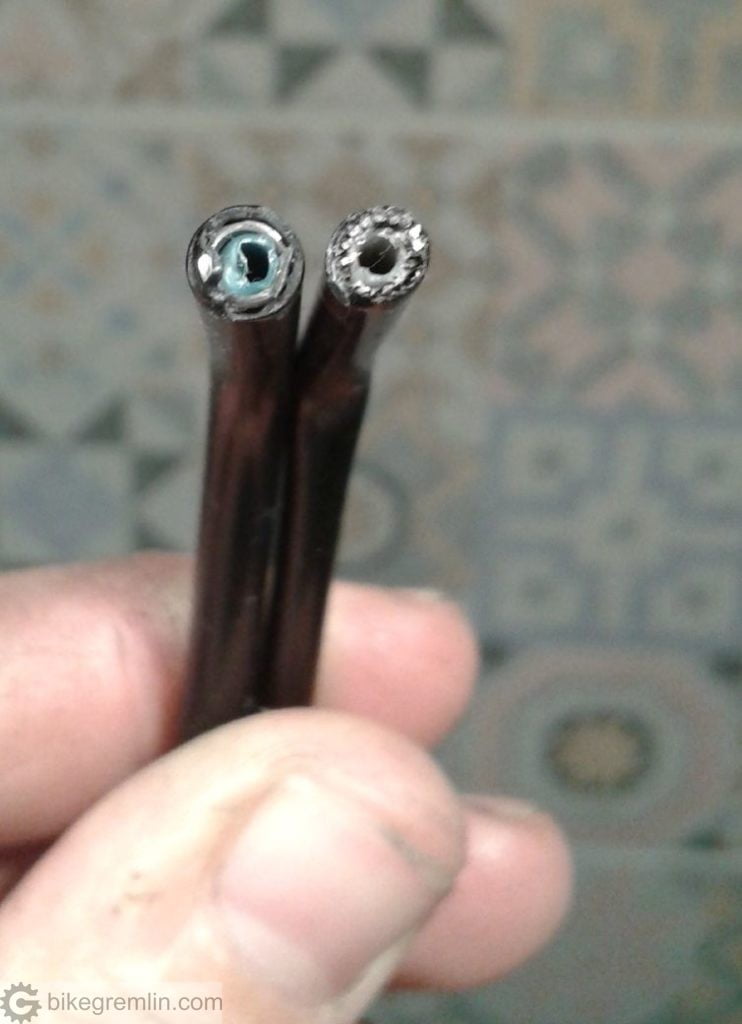
Right: shifter housing, with parallel longitudinally placed steel wires.
They are easily discerned by looking from “the front”, but one needs to pay attention.
Picture 10
6. “Exotic” models
There are special, braided brake housings that compress a lot less than “ordinary” brake housing, which is good – leaves more lever play and allows for more precise brake modulation. They are usually constructed using a layered combination of longitudinal steel wires and spiral steel, or kevlar lining to give more strength, so the housing doesn’t split when high braking force is exerted.
Such housing, due to less compression, can also be used for shifters. Though, for shifters, it is still a bit better to use shifter housing.
Their main downsides are somewhat higher weight and a lot higher price.

Picture 11
This sums it up. In case I’ve forgotten to mention something, or you have any corrections, or additions, use the comment section below.
7. My shopping recommendations
On-line shopping (Amazon affiliate links):
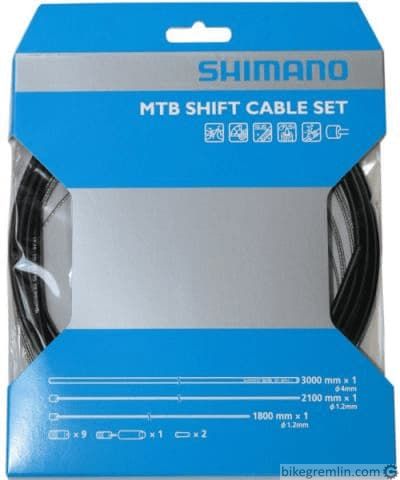
Amazon affiliate link
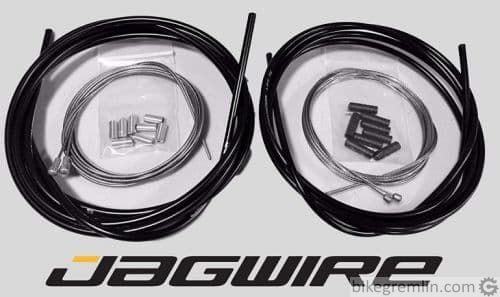
Amazon affiliate link
VIDEO: My 2-year long Shimano brake and shifter housing experiment
I wanted to test and confirm what I already believed to be true (based on the previous decades of experience): whether Shimano housing is durable and can last a long time even when exposed to the elements. That’s why I conducted this simple experiment:
Last updated:
Originally published:
Reader questions/comments and replies – below:
The existing comments posted under this article (questions and answers) have been moved to this BikeGremlin forum thread:
https://www.bikegremlin.net/threads/bicycle-shifter-brake-cable-and-housing-standards-article-comments.128/

You are so detailed I love it
Excellent article.
Any idea why cable housings labelled “Shimano SIS” would be spirallly wound (like brake cable housings)?
I was about to replace my shifter cables using the the housings with these labels, thinking that they would have to be shifter housings until I checked them a little more closely
Can I swap that question for an easier one? Higgs boson, black holes, relativity theory? Because cycling industry engineering, powered by cycling industry marketing is a mystery for the 22nd century minds to resolve. 🙂
On a more serious note:
Here, in Serbia, Shimano sells shifter housing that is 4 mm wide (outer diameter), has the spirally-coiled steel inserts, like brake housing, and is labeled as Shimano SP40 SIS.
They also sell what I consider the proper shifter housing, also 4 mm wide, labeled as Shimano OT-SP41 SIS.
In my experience, SP41 works more precisely, better, in practice.
But SP40 does work a bit better than the brake housing (I often see brake housing used for shifter cables, on the brand new low-end bicycles sold locally).
I’ll edit the article with this info – think it’s important to note, and avoid any confusion.
not all cable housing is the same,cables labled shimano sis are much stiffer cable housing and its basically used for modern road bike shifters,some cable housing is 4mm thick and some cable housing is 5 mm thick.brake cables for a mountain bike is more flexable and 5 mm thick,all brake cables have that internal spiral pattern.when purchasing mountain bike cables its a different setup to the modern road bike cables altogether.
Thanks for the clear answer.
How about some worked solutions to a few Navier-Stokes problems?
Following your confirmation, just replaced all shifter cables with OT-SP41, although the bike shop made a 500% mark up. Buying in bulk from now on.
Cheers
Geoff
all shifter cable has long straight strands,no spiral pattern at all,and shifter cable housing are much tougher than brake cable housing and they are more thiner.
if you see a cable labled shimano sis and it has a spiral pattern it is a modern road bike brake cable,i made a little mistake in my other post.most modern road bike break cables are much firmer then mountain bike brake cables
but, seriously, don’t clean your bike and forget your nails lol
Probably the most useful piece of bicycle-mechanics related advice. If I could, I’d keep this comment pinned on top of all the other comments.
After all: “cleanliness is next to godliness!”
🙂
The Shimano SIS-SP41 shifter cable housing has been pre-lubricated over its entire length with a special silicone lubricant. This reduces cable resistance by 10% (compared to SP40) and guarantees fast, precise shifting. It is not necessary to grease the cable when installing.
This is from a Shimano brochure
🙂
Hi,
Great article that provided me with all the info I needed regarding cable differences, and for that, thank you!
On another note…. would a regular pliers cut either the brake or shifter cable housing or is there a special tool for this?
Thanks
John
Hi John,
High-quality cutters, like Bahco 2101G-140 (Amazon affiliate link), can cut the cables with no problems.
For cutting the housing, pliers will pinch it noticeably. That can be undone with some hand “massage” of the housing. Slow for professional use, but OK for home use.
Of course, it’s a lot faster and easier using an appropriate tool, I love Jagwire Pro Housing Cutter (Amazon affiliate link). Stays sharp for years and cuts cleanly and nicely. This is my video review & demo of the Jagwire housing cutters.
Relja
Thank you Relja for your response, and the links too 🙂
Much appreciated!
I used to be able to take apart my bikes as a teen in the 1980s, but I’m a bit out of my depth (but enjoying re-learning) when it comes to modern bikes’ disc breaks, shifters, etc.
Thanks again, enjoying your site!
There’s one more standard for shifter cables–Brompton. Like so many parts of these wonderful but also incredibly proprietary bikes, it’s a whole different standard again. And, there’s two different kinds of those! Ugh. My own bike is sitting partly disassembled in my foyer right now.
Anyway, pre-2017, Bromptons have a very different anchor, 3 mm thick and 5 mm long. After 2017, the thickness is still the same, but they are shorter (Brompton re-did the shifting significantly in other ways, too). A post-2017 shifter cable works fine for a pre-2017 bike, but not the other way around.
Just in case someone happens to be Googling this topic, maybe they’ll find this comment. 🙂
Hey Relja,
You say in your excellent article that there is no difference in brake cable housing (all 5mm). But I’m sitting next to a 5.5 mm roll of housing right now (see it being sold here:https://www.internet-bikes.com/165274-elvedes-rem-buitenkabel-3-55-mm-10-meter-zwart/)
Any idea what the benefits of that could be, or downsides for that matter 😉
With all components shortages I find myself grabbing every piece of equipment I can…
Justin
Hi Justin,
Brake housing I’ve worked with so far could all be fitted with the 5 mm housing caps/ends (Shimano, SRAM, Promax etc.). Those caps have an inner diameter of a bit over 5 mm so they don’t fit very snugly, but the diameter is well under even 5.1 mm, so I don’t think they would fit 5.5 mm wide housing.
I’ve seen some reinforced brake housing that’s made to resist compression better – thus providing a firmer, less squishy feel on the brakes, and better modulation of the braking force. But I haven’t seen any 5.5 mm wide so far.
Do standard (Shimano) brake housing caps fit that housing? If not, do they sell wider housing ends for that housing?
Hydraulic brake hoses can be 5.5 mm wide, but I don’t know about any brake cable housing that thick.
thats a new one for me as well,all shimano brake housing i have ever seen has been 5mm wide,the only difference i have seen is some brake cable housing is more flexable for a mountain bike and more stiffer for road bikes mtb housing and slr housing,i have tried both types of brake housing on my road bikes and either type works fine,5 mm brake cable housing is the industry standard,when i worked on an older road bike the cable housing did seem thicker although i never measured it.
there would be no purpose in buying 5.5 mm housing today as all end caps i have seen are to fit 5mm housing as stated by Relja,there are two different sizes for gear housing but those are 4mm and under.
good braking depends on the whole braking system working properly,get one part wrong and the whole system fails,match up the levers with the calipers,run good pads,use the higher end stainless steel cables and cable housing,and learn how to adjust the brakes and clean brake surfaces,keep your wheels trued.
Does Shimano offer 5mm brake cable housing?
If so ehat are the choices?
Yes, Shimano does make 5 mm brake cable housing.
It’s one of the best choices in my experience – not too expensive, and good quality.
Which is better, SLR brake housing or M-system housing?
How do they compare with Jagwire’s CGX-SL brake housing?
i have not used jagwire stuff but i have used slr and m-system brake housing from shimano,slr housing is much more responsive than m-system housing,slr housing is mainly used on road bicycles and m-systems are for mountain bike brake systems,both work very good but slr system you dont get all the flex as you do with m-system housing,i mainly use all shimano stuff as you can find their stuff just about anywhere and it works very well
“all shifter cable has long straight strands,no spiral pattern at all”
That’s not true. Maybe it’s less common nowadays, but shifter cable can be spiral-wound too. It has one disadvantage: If the bending radius changes when pulling the lever, the spirals at the outer side spread slightly, which makes the effective cable length longer. It’s a small effect, which didn’t matter much when sprockets were further apart, but with today’s narrow gap between sprockets it can ruin the indexing. That’s why the cable with length-wise strands was introduced, where this effect is much smaller. These are called compression-less cables, which is a misnomer because neither type of cable can be compressed. Conclusion is that the spiral-wound SIS cables should be avoided, except for 8-speed or lower maybe.
Hi Joachim,
Just to avoid any confusion:
You (and Mike for that matter) are talking about shifter housing, not cables?
Relja
“shifter housing, not cables?”
Yes, I meant housing.
Relja, your postings are on point!!!
Normally, my competency for cable work makes the process enjoyable, save for the time I used my only record of the closed form solution to elliptical integrals I’d just derived, written on two $100 bills, folded up to make a spacer for the rear brake rotor & piston, and forgetting to remove them before taking a test ride on a very windy day. I strongly discourage the use of graph theory & currency as a brake block no matter how perfect the idea may seem.
For shifting precision, I think the important ratio is the center-to-center distance of the cog spacing vs. the total cable pull to move the derailleur over that distance.
(center-to-center distances below are only Shimano/SRAM compatible ones, pulled from Sheldon Brown’s classic spacing crib sheet)
For old Shimano 1:1.7 actuation ratio:
5/6-speed: 5.50/1.7 = 3.24 mm of cable pull to shift
7-speed: 5.00/1.7 = 2.94 mm of cable pull to shift
8-speed: 4.80/1.7 = 2.82 mm of cable pull to shift
9-speed: 4.34/1.7 = 2.55 mm of cable pull to shift
10-speed: 3.95/1.7 = 2.32 mm of cable pull to shift
As cog spacing decreased, the amount of cable pull per shift also decreased, and the slight error or play introduced by spiral-wound cable housing became a problem for the shifting precision. However for SRAM’s standard “1:1” actuation ratio, even for 10-speed cassette spacing the amount of cable pull per shift is larger than the old 5/6-speed standard using a 1:1.7 actuation ratio:
For SRAM 1:1.1 actuation ratio:
7-speed: 5.00/1.1 = 4.55 mm of cable pull to shift
8-speed: 4.80/1.1 = 4.36 mm of cable pull to shift
9-speed: 4.34/1.1 = 3.95 mm of cable pull to shift
10-speed: 3.95/1.1 = 3.59 mm of cable pull to shift
In my experience with SRAM 9-speed, this very long cable pull per shift makes it possible to use the very durable and more flexible spiral-wound brake cable housing and still have crisp shifting. i.e. any play it introduces seems to be within the acceptable error margin. After all, the rear derailleur jockey pulley also has slight side-to-side float to allow the chain to center itself on the cog once the shift is accomplished. I have not tried this setup with full-length housing, only with more traditional frames where some 2/3 of the shift cable runs between cable housing stops on the frame, keeping the total housing length fairly short.
I have also used brake housing (and spiral-wound Shimano SP40 SIS shifter housing) with Shimano setups using 1:1.7 actuation, but in that case the shifting quality is definitely degraded. For the setups I have built, it usually works acceptably up to 8-speed cog spacing, but success is partly dependent on the exact setup (i.e. how closely does the jockey pulley follow the cassette profile as it shifts).
My guess is that this progressive degradation in shifting quality with reduced cog spacing is a significant part of the reason that Shimano changed the actuation ratios of their shift mechanisms in the most recent iterations. It is a good solution to the root problem, and I find it funny that in the most extreme case they have arrived at essentially the same actuation ratio as the SRAM “1:1” design.
Hi Aaron,
Very nicely explained and I completely agree.
Yes, it is ironic how it took Shimano “only” a decade or so to reach the same “conclusion” that SRAM did. 🙂
Relja Novovic